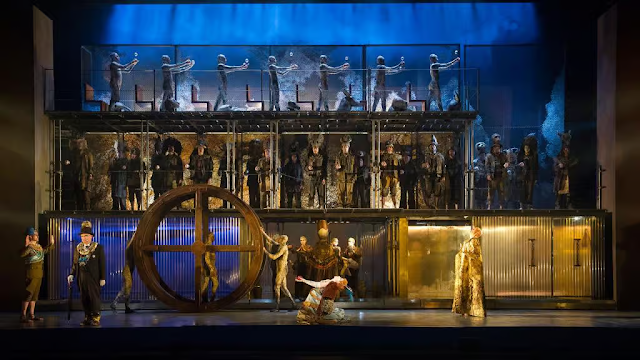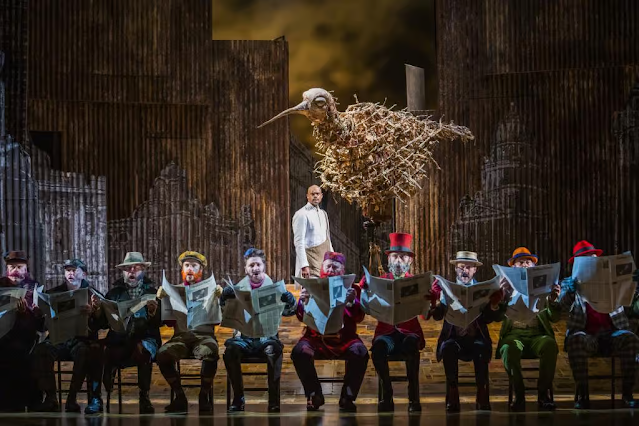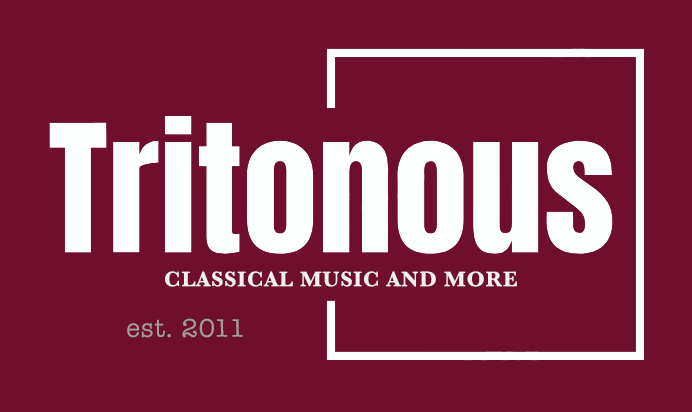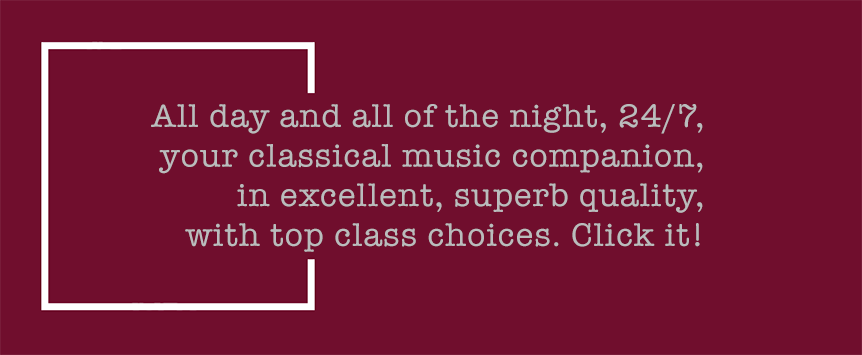 |
| Philip Glass: Akhnaten – English National Opera, 2016 (Photo: © Richard Hubert Smith) |
Philip Glass: Glassworks plus excerpts from Satyagraha, Akhnaten and The Photographer; Lisa Bielawa, Peter Hess. Mick Ross, Sam Sadigursky, Andrew Sterman, Philip Glass Ensemble, music director Michael Riesman, sound engineers Dan Bora, Ryan Kelly, production manager Michael Amacio; Cambridge Music Festival at Cambridge Corn Exchange
Reviewed by Tony Cooper, 1 October 2024
Philip Glass’ music is instantly recognisable with its pulsating rhythms, hypnotic repetition and slowly shifting patterns of notes. His music sits somewhere between classical music and rock, intricately constructed yet filled with familiar chords and clean-cut electronic sounds
Showing talent from a very early age, Philip Glass, born 31 January 1937 in Baltimore, Maryland, widely regarded as one of the most influential musicians of the 21st century, developed his great love of music from his father who owned a record shop. He later discovered that many relations on his father’s side of the family had been musicians, too, including a cousin (pianist) as well as several vaudeville performers. His parents, Latvian and Russian-Jewish emigrants, helped Holocaust survivors at the end of the Second World War by welcoming them into their home to learn English, find a job and rebuild their lives in the United States.
Employing short ideas which gradually change resulting in an exceptionally hypnotic-layered effect so associated with minimalism, Glass much prefers to describe his work as ‘music with repetitive structures’. Therefore, over the course of a long and distinguished career, he has evolved such repetitive structures to produce a style that is instantly recognisable as a piece of ‘Philip Glass music’.
Originally a flautist, Glass eventually focused his musical education on the keyboard. By the age of 15, he was studying mathematics and philosophy at the University of Chicago followed by composition at New York’s Juilliard School where among his fellow students was Steve Reich, widely recognised as the ‘founding father’ of the ‘Minimalist movement’. Fellow Americans such as La Monte Young, Terry Riley, Moondog and, indeed, John Adams, were in the front line in developing compositional techniques exploiting a minimalistic approach to music.
After studying in Aspen with Darius Milhaud and later in Paris with Nadia Boulanger, Glass soon rejected the popular style of his contemporaries which he considered to be music of the past masquerading as music of the present. While in the French capital, Glass became enamoured with French New Wave cinema as well as the contemporary theatre scene.
He regularly attended theatre productions and made friends with actors, artists and directors of the day. This was a formative period which resulted in him contributing music to the staging of Samuel Beckett’s one-act play, Play, in 1965 while composing his first film score for Chappaqua in 1967, written and directed by Conrad Rooks – the scenario based on Rooks’ experiences with drug addiction.
While he was making his way as a composer in the pioneering decades of 1960s and ’70s, Glass supported himself by working as a waiter, plumber and cabbie – whatever! A prolific writer, though, he drove on and developed a distinguished movie soundtrack repertoire that included the score for Candyman (1992) and The Illusionist (2006) as well as his award-winning pieces for Martin Scorsese’s 1997 film, Kundun. A year later came The Truman Show followed in 2002 by The Hours and Notes on a Scandal, 2006. Therefore, in total, Glass (who has collaborated with the likes of Twyla Tharp, Allen Ginsberg, David Bowie and Woody Allen) has written 25 operas as well as 14 symphonies, 11 concertos and a great deal of chamber/choral music.
Other compositions and operas of Glass include Mad Rush (1979), originally written for the Dalai Lama’s first public address in North America; Satyagraha (1980), loosely based on the life of Gandhi, the second part of Glass’ ‘portrait’ trilogy of operas about men who changed the world. It was originally timed to celebrate the 60th anniversary of India’s independence from Great Britain and, indeed, Philip Glass’ 60th birthday.
And in 1982, Glassworks entered Glass’ repertoire followed by Akhnaten in 1983, the third of Glass’ ‘portrait’ trilogy based on the life of the Pharaoh Akhnaten while Prophecies (1983), written for the pioneering art film, Koyaanisqatsi, found great favour while Glass’ Violin Concerto of 1987 proved to be one of his most popular and interesting works influenced by memories of his father. Another interesting and formative piece, Metamorphosis, inspired by Franz Kafka’s novella of the same name, came out in 1989.
However, it was Glass’ Einstein on the Beach, set to a libretto by Robert Wilson, that launched his international career. Comprising five one-hour acts it’s Glass’ largest work receiving its première on 25 July 1976 at the Théâtre Municipal, Avignon, as part of the city’s international festival.
The production came to London staged at the Barbican Theatre on Friday 4 May 2012 performed by the Philip Glass Ensemble conducted by Michael Riesman, playing to a full house. And, to boot, it was performed without an interval although members of the audience were invited to come and go as they wished. I was glad to be a member of that audience and equally glad to be stuck in my seat throughout the whole duration of the five-hour show.
 |
| Philip Glass: Satygraha – Sean Panikkar – English National Opera, 2021 (Photo: © Tristram Kenton) |
The production of Satyagraha for English National Opera at the London Coliseum in 2007 in a co-production with The Met, New York, was a brilliant and stunning production directed by Phelim McDermott winning an Olivier Award for Best New Opera Production. This production is widely recognised as cementing English National Opera’s reputation as the ‘House of Glass’.
However, this magnificent theatre in St Martin’s Lane designed by Frank Matcham was originally known as the ‘House of Sir Oswald Stoll’ who had it built as his ‘flagship’ music-hall. It opened in a blaze of glory on 24 December 1904 as the ‘London Coliseum Theatre of Varieties’ lovingly described as the ‘People’s Palace of Entertainment’. It still is! The production of Satyagraha, however, became the ‘first’ in the ongoing partnership between Phelim McDermott (co-founder of Improbable with Julian Crouch) and ENO.
Without any shadow of doubt, Satyagraha was an outright and riveting success breaking box-office records therefore making the production one of the most popular contemporary operas ever to be staged by ENO. It has been revived four times: 2010, 2013, 2018, 2021. An expert on the work of Philip Glass, Karen Kamensek conducted the 2018 production to great acclaim while she also took to the pit for the première of Glass’ Orphée in New York with the Brooklyn Philharmonic Orchestra as well as for the world première of Les Enfants Terribles at the Spoleto Festival.
A director flying high, McDermott also delivered a superb production of Akhnaten (a co-production with ENO and LA Opera) which premièred in 2016 at the London Coliseum with revivals coming round in 2019 and 2023. A sell-out run for its first outing and, indeed, for its revivals, the opera was an Olivier Award winner. In fact, Akhnaten (meaning ‘spirit of Aten’ the Sun God) is the last of the composer’s trilogy of ‘portrait’ operas exploring the lives of three great historical figures namely Einstein (science), Gandhi (politics) and Akhnaten (religion). Not surprisingly, both of McDermott/Glass productions have become jewels in ENO’s glittering and untarnished crown.
Therefore, boo to the brigade of doubters who bemoan the fact that the London Coliseum’s vast auditorium is hard to fill and simply too large and unworkable for some of its productions. Not so for the likes of Glass, Adams and Wagner, it seems. In fact, ENO has been doing very well of late presenting works by this masterful trio of composers. And always adventurous in its programming, ENO also presented the UK première of Glass’ The Perfect American in 2013.
Enjoying a fascination with Indian culture and classical music led Glass to visit India to work with the pre-eminent sitar player, Ravi Shankar. He ended up as his assistant. For example, in Satyagraha, Glass uses Sanskrit, an ancient and classical language and still the official language of India as well as texts sung in their original languages for Akhnaten and Einstein on the Beach setting single words over long paragraphs of music that the literal meaning is sometimes hard to discern.
Therefore, this concert by the Philip Glass Ensemble (PGE) at the Cambridge Corn Exchange as part of the Cambridge Music Festival offered me an interesting insight into Glass’ music well away from the confines of the opera-house.
However, I fondly recall seeing Glass and Laurie Anderson (who first met in the blossoming communal arts scene of writers, dancers, sculptors and composers in Lower Manhattan in the early 1970s) at Norwich Theatre Royal as part of the Norfolk & Norwich Festival in 2017 for one of their first ‘live’ performances together outside of America. They delivered a highly creative collaborative experience involving prose, song and visual work as part of Glass’ 80th birthday celebrations.
In fact, Glass and Anderson, the first ‘artist-in-residence’ at America’s space agency, NASA, have previously appeared at the Norfolk & Norwich Festival. Glass turned up in 2009 and performing a brilliant solo show (best described, I guess, as a lecture recital) equipped with just an upright piano and a glass of water while Anderson checked in at Norwich a year earlier. Their performances are indelibly printed in my memory.
And how glad I am to be a member of the audience to see the PGE in Cambridge – the group last played the venue in 2014. Comprising six absolutely first-class musicians playing a variety of keyboards and woodwinds amplified and fed through a mixer, PGE was formed in 1968 acting as Glass’ original ‘laboratory’ where he could experiment with new ideas and new sounds while the musicians could develop the control and superhuman concentration needed to play his music.
Arriving on stage to a rush of rapturous applause from a full house, PGE (under the direction of Michael Riesman) kick-started their Cambridge gig with Glassworks, offering a masterful account of one of the composer’s cult iconic works dating from 1981 comprising six short movements, pop-orientated and written with easily accessible and digestible tracks to fit in with the new ‘Walkman generation’.
Roughly, a 40-minute piece, Glassworks opening witnessed Riesman seated at a grand piano with his back to the audience with a white solo spotlight trained upon him. He played the best part of ten minutes bar upon bar of linear-structured wave-like chords in a style not too dissimilar to the music of that great baroque master, JS Bach, a composer greatly favoured by Glass. Dramatically placed in Riesman’s shadow, seated in a half-light at their work-desk awaiting their cue, were the other five members of PGE.
Comprising Lisa Bielawa (voice/keyboard), Peter Hess (alto/tenor saxophone), Mick Rossi (keyboard), Sam Sadigursky (soprano saxophone/flute) and Andrew Sterman (flute, piccolo, soprano saxophone) the brilliance of their performance was greatly enhanced by the technical wizardry conjured up by off-stage sound engineer Dan Bora and onstage sound engineer Ryan Kelly while production manager, Michael Amacio, kept everyone in check!
In fact, Glassworks is a prime example of Glass’ writing: soothing, spiritual and spellbinding to say the least intricately constructed yet filled with familiar chords and clean electronic sounds. His pulsating arpeggio soundscape is thoroughly engaging and strongly illuminating thereby demonstrating his definitive style of music comprising repetitive structures thus creating a shifting, hypnotic effect which I found immersive and meditative with a spiritual leaning to it.
Out of the six movements that make up Glassworks I found myself transfixed on No.5 (Façades) featuring Riesman and Rossi on keyboards with Sam Sadigursky’s soprano saxophone line truly focused on a series of pounding repetitive phrases freely floating over the keyboards with consummate ease. The work ended with Riesman quietly shuffling from keyboard to grand piano but this time round playing in league with PGE’s full ensemble thereby bringing the first part of this thrilling and engaging concert to a fulfilling and rewarding close.
During the interval, members of the audience seemed to be on fire with the way the night was unfolding. The enthusiasm and the expectancy for the second half was running high and I don’t think anyone was disappointed as to what PGE served up. It was feast! In fact, a feast of Philip Glass like no other!
Therefore, the second half opened with Satyagraha (act II): Confrontation and Rescue, comprising a stream of soft-sounding pulsating and ever-changing moods of tempo and pitch punctuating Glass distinctive style of writing which as a listener grabs your attention completely absorbing you into the score – and more!
A scene from Akhnaten followed (Funeral of Amenhotep III, act I) with funereal percussive sounds heard at regular intervals throughout the work signalling and offering serene respect to the late king. But propelling sensitivity, mood and feeling to the scene overall, Glass penned some lovely inspiring and sensitive passages of vocal writing adorably performed by Lisa Bielawa, an extraordinary singer and keyboard performer, too. Calming and hauntingly beautiful, her clear-cut and well-controlled voice floated over the instrumental line to exacting and mesmerising effect in a totally absorbing performance.
The final work of the printed programme, The Photographer (act III), a mixed-media work set to a libretto by David Byrne (Talking Heads) opens in a mad and impatient flurry of wave-like chords emanating from the keyboards heavily punctuated by driving and screaming woodwind (shades of Stravinsky here!) of incidental pieces of music that fit neatly into the three-act play recounting and conjuring up all sorts of thoughts and ideas about the protagonist of the story, the 19th-century English-born photographer, Eadweard Muybridge, who in 1874 murdered Major Harry Larkyns suspected of being his wife’s lover. Dramatic to the core, the work was commissioned by the Holland Festival and first performed in 1982 at the Royal Palace of Amsterdam with Princess Beatrix and Prince Claus, her husband, in attendance. I wonder what they thought of it!
And when one thought it was all over, it wasn’t. Following frantic and ecstatic curtain-calls, members of PGE excitedly rushed to their work-desks to deliver their encore, a piece from Einstein on the Beach (Spaceship: act IV) thereby truly rounding off a brilliant and entertaining programme of the music of Philip Glass, the once-struggling composer who made ends meet by working as a waiter, plumber and cabbie. He has contributed and made such an extraordinary impact on the musical life of our times and not only has he influenced contemporary popular music he has also brought new audiences to contemporary opera as well. Bravo!
Breaking Glass: In February next year, the Hallé, in collaboration with the RNCM, will be presenting a three-day celebration of the music of Philip Glass performing some of his best-loved works. Check out this mini-Glass Fest by visiting the website.
The blog is free, but I’d be delighted if you were to show your appreciation by buying me a coffee.
Elsewhere on this blog
- Everyone clearly enjoyed themselves & brought the house down: The Sixteen in Monteverdi’s Vespers of 1610 at Temple Church – concert review
- Une messe imaginaire: Bruckner & Frank Martin from Lyon – record review
- What lies beneath: a brilliant reinvention of Judith Weir’s Blond Eckbert at the heart of ETO’s exploration of German Romanticism – opera review
- A glorious noise: from one to eight choirs in I Fagiolini’s evening of music from 17th-century Venice and Rome – concert review
- After the humans are gone, the instruments still sing and it is important to listen – Jake Heggie on his song cycle, Intonations: Songs from the Violins of Hope – interview
- Innate theatricality: composer Adrian Sutton definitively moves out of the theatre with a challenging yet engaging concerto for violinist Fenella Humphreys – record review
- Eternity In An Hour: Keval Shah and Jess Dandy on their unique reimagining of the Bhagavad Gita – feature
- A focus on the flute: London Handel Players in a group of cantatas Bach wrote in 1724 with virtuoso flute parts – concert review
- A special treat: strong individual performances & superb ensemble in WNO’s revival of Puccini’s Il trittico – opera review
- Embodied sound: Zubin Kanga on his innovative approach to new technology through his interdisciplinary musical programmes – interview
- Home






